Geochemistry and petrology of rift-related mafic sills and arc-related Gabbro–Diorite bodies,Northern Bafq District,Central Iran
2018-06-27NiktabarRashidnejadOmran
S.M.Niktabar•N.Rashidnejad Omran
1 Introduction
The Central Iranian Terrane is an approximately 2300 km2region of moderate relief surrounded by fold-and-thrust belts,within the Alpine–Himalayan orogenicsystem(Ramezani and Tucker 2003).The concept of a distinct and fault-bounded Central-East Iranian Micro-continent(CEIM),which was once encircled by Red Sea—type oceanic tracts now represented by strips of ophiolitic rocks,was first introduced by Takin(1972).From Paleozoic to Triassic time,CEIM appears to have approached and collided with the Turan Plate(Schmidt and Soffel 1983).
The Precambrian(formerly Infracambrian)volcanic rocks in Central Iran are related to deep crustal cracks that formed during the Katangian orogeny.Alkaline volcanic rocks suggest a within-plate rift in the Iranian cratonic crust.A commonly proposed model for the Late Neoproterozoic–Early Cambrian magmatism and sedimentation in Iran is crustal extension associated with continental rifting(Berberian and King 1981;Samani 1988).
The Rizu intrusions(sills)seem to have intruded parallel to the Precambrian Rizu Formation(in the vicinity of Zarigan village)in the north of the Bafq district,which is consistent with the hypothesis of carbonate-alkaline volcanic rock alternation.In this paper,the gabbroic sills in the Rizu Formation are discussed for the first time.The sills contain important clues about the tectonic-magmatic evolution.They have previously been compared with Gabbro–Diorite intrusions in the region.
Gabbro–Diorite intrusion bodies are situated in Precambrian metamorphic complexes in the vicinity of the Rizu Formation.The study area has been affected by several stages of plutonism,from Precambrian to Tertiary(Haghipour 1974),but there is no general agreement on age of emplacement.
Generally,most of the hypotheses presented for the geodynamic of Central Iran have been divided into two groups(Ramezani and Tucker 2003).In the old model,the geologic structure of the area was based on horsts of highgrade metamorphic rocks of the Chapedony Formation,and grabens covered by thick Phanerozoic sediments(Stocklin 1968;Haghipour 1977;Nadimi 2007).In the new model,subduction of the Arabian Plate beneath CEIM—resulting in a primarily extensional regime and crustal thinning—caused upwelling of asthenosphere(Ramezani and Tucker 2003;Kargaran et al.2006;Verdel et al.2007;Kargaranbafghi et al.2010,2011).
The main purpose of this paper is to present and discuss new geochemical results from the intrusions,including comparing the intrusions within the study area.Petrographic and geochemical data helped clarify the origin and tectonic evolution of the intrusions.
2 Geologic setting
The Central Iranian Terrane consists,from east to west,of three major crustal domains:the Lut,Tabas,and Yazd Blocks(Alavi and Kishvar 1991).These blocks are separated by a series of intersecting regional-scale faults.The study region is located between the Tabas and Yazd Blocks(Fig.1).
Isochron data and other evidence have confirmed the presence of a Precambrian crust in this region(Huckriede et al.1962;Ramezani and Tucker 2003).
The Rizu Formation and other units are shown on a generalized geologic map(Fig.2).The Rizu Formation is the lowest stratigraphic unit above the post–Katangian orogeny disconformity.Structuralwarp and cropped domica have caused stratigraphic disorder.The Rizu Formation mainly consists of carbonates on the top;shale and sandstone in the middle;and basalt,andesite,violet rhyolite,and tuff at the bottom(Huckriede et al.1962).Fossil evidence and radiogenic age data favor a Precambrian age for the Rizu Formation(Berberian and King 1981).Intrusive sills exist in the Rizu Formation(Figs.2,3a).
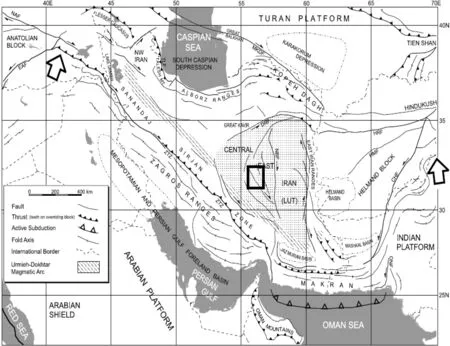
Fig.1 Simplified structural map of Iran and adjacent region(compiled from Berberian and Berberian 1981;Jackson and McKenzie 1984;Alavi and Kishvar 1991);extent of study in bold black rectangle
Older metamorphic complexes,known as the Boneh Shurow and Chapedony,have also been intruded by Gabbro–Diorite bodies(Figs.2,3b).Haghipour(1977)proposed a Precambrian age for these intrusions,whereas Majidi and Babakhani(2000)suggested Triassic age based on stratigraphic relationships.Berberian and Berberian(1981)concluded that plutonic rocks of the area are subalkaline in nature.
3 Petrography
The sills in the Rizu Formation are 5–15 m in width,and a few tens of meters long.In some cases,melanocratic sills are in contact with volcanic rocks or with carbonates.Occasional brown margins of 1–5 cm on the side of carbonate rocks are evidence of lime reactions,and show weak deformation and injection of iron oxide and manganese.In some cases,pegmatite bands of mafic minerals and large grains of plagioclase within the gabbroic sills suggest the phenomenon of the final gaseous liquids(balance intense ion).Onion-skin erosion and surface weathering can be seen on some of these masses.
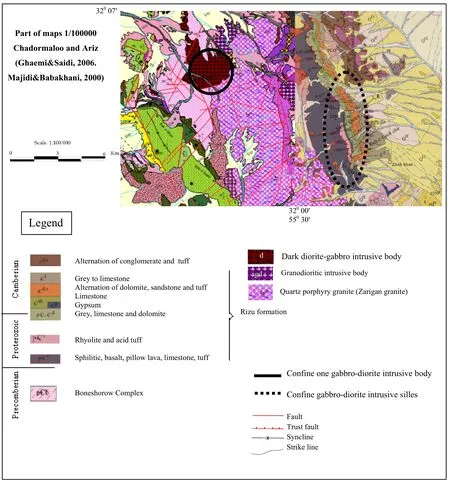
Fig.2 Extent of gabbroic sills in Rizu Formation and Gabbro–Diorite intrusive body in the region
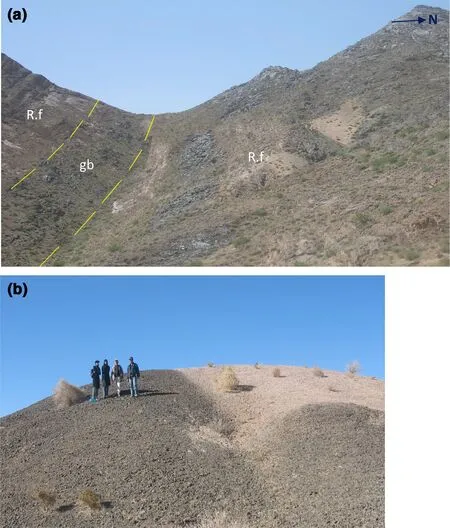
Fig.3 a Gabbroic sill(gb)of 5–15 m width and a few tens of meters in length within the Rizu Formation(R.f);b Gabbro–Diorite body with dark color has intruded in the old complexes
Melanocratic Gabbro–Diorite bodies have been observed in small and large bodies without specific reactions to enclosing old metamorphic complex rocks(Fig.3b).
The olivine-gabbro of the sill facies generally showed granular to poikilitic texture(Fig.4a).Major components of the samples were olivine,pyroxene,pyroxene altered to brown amphibole,brown amphibole,and calcic plagioclase(An52–80by the method of Michel-levy).Acicular Apatites,sphene,and magnetite constituted the accessory minerals,and epidote,sericite,amphibole,chlorite,apatite,and carbonate the secondary minerals.
The gabbroic rocks of the sill facies showed intergranular to ophitic texture.Major components were intermediate plagioclase,pyroxene,brown amphibole,and biotite.Alkali-feldspar,ilmenite,sphene,and apatite occurred as accessory minerals.Secondary minerals included tremolite/actinolite and chlorite replacing hornblende and biotite;and sericite,epidote,and occasionally carbonate partially replacing plagioclase(Fig.4b,c).
Retrograde metamorphism—likely weak green schist facies—might have resulted from the presence of amphibole minerals in some rocks.For instance,pyroxenes have been partly replaced by green amphiboles along the margins.

Fig.4 a Olivine–gabbroic rock with olivine,pyroxene,and plagioclase;b gabbroic rocks from relime(poiklitic)to(c)ophitic intrusive sills,with brown amphibole(probably kaersutite),pyroxene and plagioclase;d,e Gabbro–Diorite bodies with green hornblende and plagioclase

Table 1 Whole-rock major element compositions(wt%),and trace element and whole-rock rare earth element compositions(ppm)of the Rizu gabbroic sills and other Gabbro–Diorite bodies in the region;mafic Sills(code 8)in the Rizu Formation;Gabbro–Diorite bodies(code 3)in the metamorphic complexes;(*)ICP-MS analysis(without*)XRF analysis
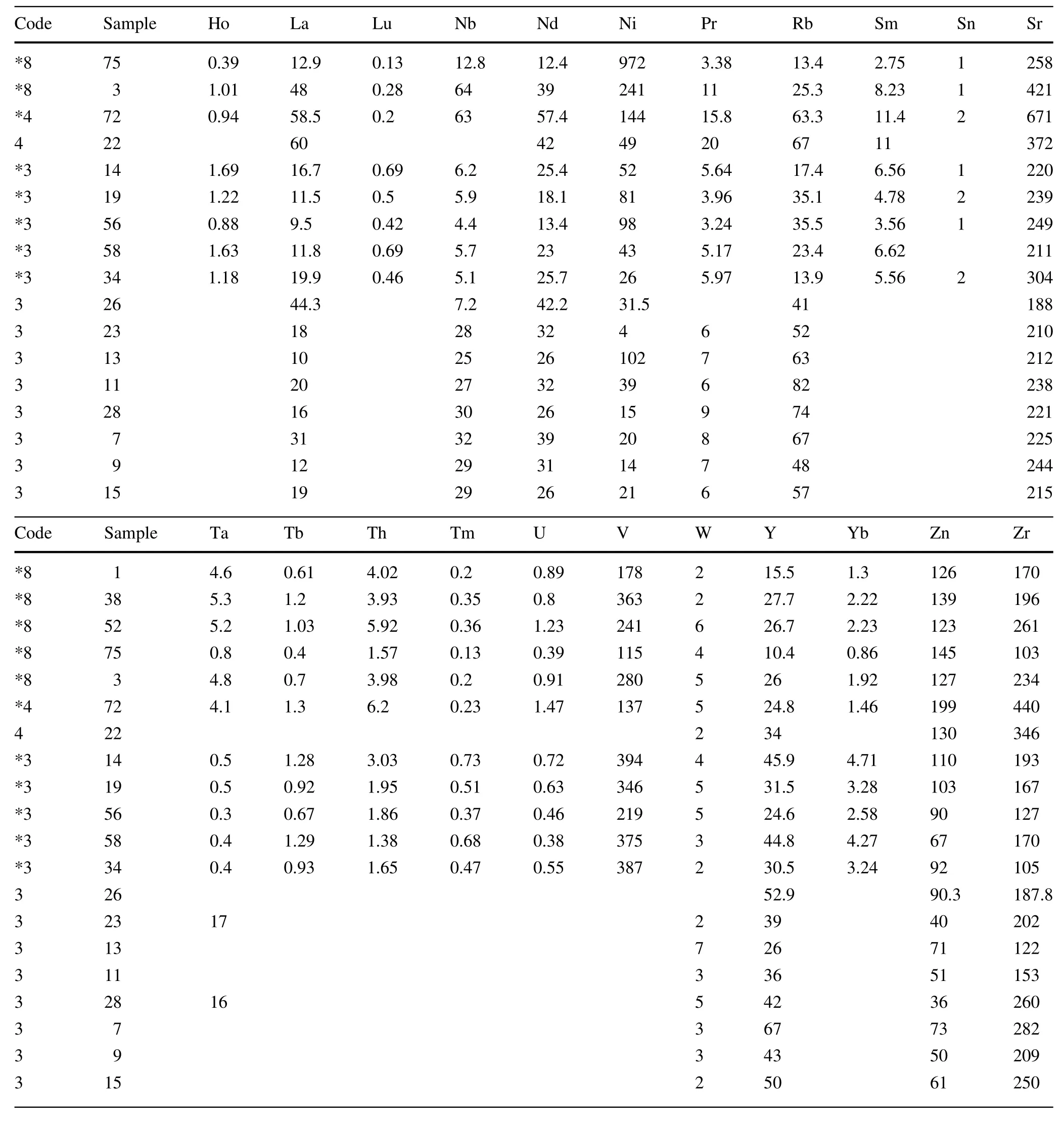
Table 1 continued
The Gabbro–Diorite bodies in the old metamorphic complexes are characterized by calcic to sodic plagioclase,pyroxene(augite),amphibole(hornblende),and biotite as major components(Fig.4d,e).The minerals,especially amphiboles,vary in gabbroic sills and Gabbro–Diorite bodies.Brown amphiboles with extinction 5°–10°(probably kaersutite)were observed in the gabbroic sillsand green hornblende in Gabbro–Diorite bodies.
4 Geochemistry

Fig.5 Geochemical classification and names of rock intrusions using total alkalis–silica diagram(Cox et al.1979)
Mafic intrusions,including sills and bodies,were sampled.Representative samples were collected for analysis.The samples were analyzed by inductively coupled plasma–mass spectrometry(ICP-MS)at the ALS Chemex Company in Vancouver,Canada and X-ray fluorescence(XRF)at Tarbiat Modares University,Iran.In some diagrams,only ICP-MS data were used.Whole-rock major,trace,and rare earth element(REE)compositions of the intrusions(Table 1)were used to determine the main characteristics of the initial magma source and the processes that modified the initial magma composition.
Data from samples of different intrusions were plotted in a chemical nomenclature diagram proposed by Cox et al.(1979).Rizu sill samples plotted in the field of olivinegabbro to gabbro;metamorphic complex intrusions plotted in the field of gabbro to diorite,consistent with mineralogical data(Fig.5).
Rock samples taken from intrusions of the region display two distinct trends.The gabbroic facies sills in the Rizu followed a good alkaline trend while other Gabbro–Diorite bodies followed a subalkaline trend in the diagram of total alkalis versus silica(Fig.5).
Wilson(1989)proposed diagrams to explain the genesis of basic-mafic igneous rocks.Two of these—the variation of Al2O3and CaO contents versus MgO content—suggest that olivine and plagioclase accumulation/fractionation were dominant in the genesis of olivine gabbroic facies and gabbroic rocks,respectively,in the Rizu intrusions.Fractionation is necessary to explain the formation of olivine gabbroic main bodies in the early stage,and gabbroic rocks in the late stage from a single magma source.The mineralogical compositions of the Gabbro–Diorite bodies represent plagioclase accumulation/fractionation from a single magma source(Fig.6a,b).
The chondrite-normalized spider diagram of Rizu sills supports fractional crystallization(FC)(Fig.7).The pattern of the diagram results from a high amount of olivine,which is an insensitive mafic mineral associated with REE fractionation.REE and trace element distribution patterns of alkaline samples(Rizu intrusions)show positive anomaly trends in large-ion lithophile elements(LILEs),light and medium REEs(LREEs and MREEs),Nb,and Ta—elements related to alkaline within plate magmatism and similar to enriched mantle rock(McDonough and Frey 1989).
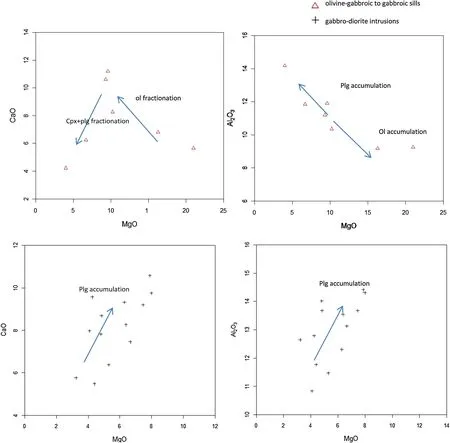
Fig.6 Major element variograms of rock samples from Rizu gabbroic sills and Gabbro–Diorite bodies.Arrows show trend of crystallization of minerals
The most characteristic high- field strength elements(HFSE)of Gabbro–Diorite bodies,e.g.Nb,Ta,Zr,Y,Ti,and heavy REEs(HREEs),had clearly lower normalized values compared to LILEs.Nb,Ta,and Ti show negative anomalies(Fig.7).Additionally,samples were enriched in LILEs that behave as incompatible elements(Rb and K).These characteristics are related to subduction-related magma,including calc-alkaline volcanic arcs of continental active margins(Gill 1981;Pearce 1983;Wilson 1989;Walker et al.2001),and are distinct from the Rizu sills(Fig.7).Based on the geochemical and petrographic evidence presented above,negative Ti anomalies are thought to be associated with oxide fractionation;negative phosphorus anomalies in the studied samples are attributed to apatite fractionation.
5 Petrogenetic and geodynamic interpretations
Mineralogical-petrological and geochemical(major,trace,and REE)data demonstrate that FC modified the primary composition of a single mafic-basic magma source.
The Rizu intrusions and Gabbro–Diorite bodies formed from different mafic-basic magma sources by differentiation and crystallization processes.
Highly incompatible element ratios minimize the effects of differentiation and provide the characteristics of a mantle source.The origin of the difference is reflected by different correlations in this ratio(Rollinson 1993).In the diagram proposed by Saunders et al.(1988),different trends may confirm distinct magma sources for the mafic sills and Gabbro–Diorite bodies in the region(Fig.8).

Fig.7 a Rock/chondrite spider diagrams of the Rizu gabbroic sills and b rock/chondrite spider diagram of the Gabbro–Diorite bodies(Thompson 1982)
There are two trends on the MgO versus Zr diagram of Wilson(1989)(Fig.9).The horizontal trend explains the different degrees of partial melting in the case of more than one magma source in the genesis of basic-mafic igneous rocks,consisting of different types of rocks,and the diagonal trend represents fractionation to form different rock types from a single basic-mafic magma source.In the light of field,mineralogical,and geochemical data,the MgO–Zr variogram of the rock types of the Rizu intrusions can be considered to indicate a single mafic-basic magma source and Gabbro–Diorite bodies can be considered to have formed from another single mafic-basic magma source(Fig.9).
It is crucial to note that Rizu intrusions are alkaline and exhibit the geochemical characteristics of within-plate intrusion.These are different from other intrusions in the region with different tectono-magmatic characteristics and magma sources.
Partial melting of upper mantle material in such a geologic context is mainly generated by lithospheric attenuation under the tensional regime that created the immature rift that later closed(Harris et al.1986;Wilson 1989;Prichard et al.1993).
According to Bailey(1983),alkaline magmatic activity is generally controlled by the withdrawal of accumulated magma from volatiles originating from the mantle areas,and fractures in the continental lithosphere acting as magmatic channels.Volatile and incompatible elements in large mantle tanks escape through narrow fractures and rift zones.This results in metasomatism or melting a part and an expansion in mantle rock and the crust surrounding the tracts.
In turn,the sills develop a within-plate character with enriched mantle source.Emplacement of the Rizu intrusions was contemporaneous with the development of the rift.The characteristics of gabbroic sills,including high K2O+Na2O,Fe/Mg,Zr,Nb,Y,and REEs,are consistent with an anorogenic origin(Loiselle 1979).

Fig.8 Incompatible element ratio diagram(Saunder et al.1988)
Geological studies have demonstrated that the geochemical characteristics of Gabbro–Diorite bodies are similar to those of subduction-related magmas attributed to the movements of CEIM relative to the Turan Plate and/or the subduction of the Arabian Plate beneath CEIM. The Gabbro–Diorite bodies are sub-alkaline and have characteristics of an active continental margin.As indicated in Fig.8,their anomalies can be alternatively explained by adding slab elements to the mantle wedge from dehydrated subducted oceanic crust,increasing several incompatible elements(Turner et al.2003;Wang et al.2006;Tamura et al.2011).
As has been established in the literature,if particular geochemical characteristics of intrusive rocks can be correlated with their specific tectonic setting,these data can be used to identify the tectonic setting of ancient volcanic sequences.
However,this approach by itself is unlikely to give an unambiguous determination of tectonic setting(Wilson 1989).The composition of basaltic magmas depends on their source composition and mineralogy;their depth,type,and degree of partial melting;and the degree of partial crystallization at the surface(Wilson 1989).Figures proposed by Meschede(1986)and Harris et al.(1986)have provided meaningful evaluations.All of the rock samples of the gabbroic sills aligned with within-plate alkaline chemistry,and the samples from sub-alkaline Gabbro–Diorite intrusions were identified as volcanic arc–related magmatism(Fig.10a,b).
In order to interpret the geotectonic environment of each lithologic unit,stratigraphic position,mineralogical-geochemical characteristics,and regional geologic setting must be considered together,rather than merely evaluating geochemical discrimination diagrams.As the samples from the studied sills were sodic alkaline(Na2O>K2O),they cannot be related to Volcanic Arc Basalt(VAB)or Island Arc,but they can be related to the within-plate continental environment(Middlemost 1985).Based on the evidence,this would be a within-plate environment in which an upper mantle source material was melted by adiabatic decompression(Best 1982;Wilson 1989)due to lithospheric attenuation.In this context,the Rizu gabbroic sills seem to be syngenetic or syntectonomagmatic with alkaline volcanics in the rift realm(Rizu Formation).Thus,the Rizu intrusions can be considered alkaline within-plate mafic intermediate sills,consistent with models presented previously regarding alkaline volcanic rocks in the region.The regional volcanic rocks(rhyolite,felsic tuffs,and quartzporphyries)have been interpreted as products of postorogenic,extensional magmatism(syn-rift)of the Rizu Formation(Berberian and King 1981;Husseini 1989).
In contrast,the studied samples from sub-alkaline Gabbro–Diorite intrusions can be related to volcanic arc magmatism.

Fig.9 Trace and major element variograms of rock samples from Rizu gabbroic sills and Gabbro–Diorite bodies(Wilson 1989)
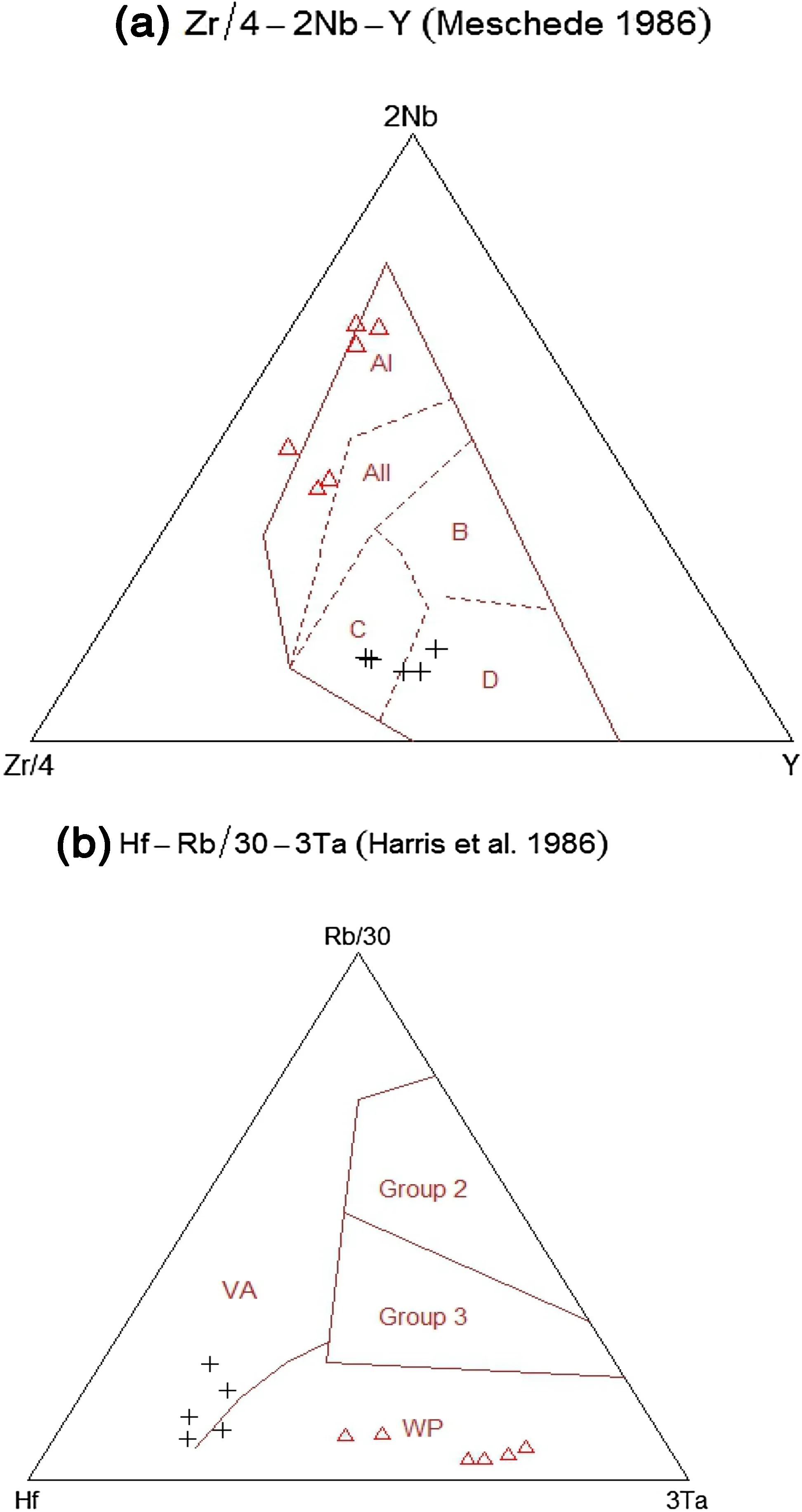
Fig.10 a Nomination of basalts tectonomagma environment in base of Zr–Nb–Y (Meschede 1986) and b base of Hf–Rb–Ta (Harris et al. 1986)
6 Conclusion
Two types of mafic intrusions with different natures were distinguished in the north of the Bafq district:(1)those emplaced only in the Rizu Formation—the gabbroic sills intruded into the carbonate-volcanic sequence and the mafic sills intruded in the Rizu Formation,consisting of olivine-gabbro to gabbroic facies;and(2)Gabbro–Diorite bodies situated in nearby Precambrian metamorphic complexes.The gabbroic sills and the Gabbro–Diorite bodies had distinct magma sources.
When the data of the Rizu sills are considered in the regional context,we suggest that these intrusions are representative products of within-plate alkaline magmatism.Such magma could have been generated by partial melting of upper mantle source rocks via adiabatic decompression under a tensional regime,resulting in a mantle plume that fed alkaline gabbroic sills and alkaline volcanic rocks in the rift realm.REE geochemical modeling of the intrusions revealed that the magma was derived from enriched mantle.
The mafic sills from the Rizu Formation had different petrographic and geochemical characteristics from other Gabbro–Diorite bodies in the surrounding metamorphic complexes.The Gabbro–Diorite intrusions reflect sub-alkaline tectonomagma and magma sources related to volcanic arc magmatism.For clarification of this assumption,we suggest the intrusions be evaluated through absolute age dating.
Alavi M,Kishvar S(1991)Tectonic map of the Middle East:geological survey of Iran
Bailey D(1983)The chemical and thermal evolution of rifts.Tectonophysics 94(1–4):585–597
Berberian F,Berberian M(1981)Tectonic-plutonic episodes in Iran.In:Gupta HK,Delany FM(eds)Zagros-Hindu Kush-Himalaya geodynamic evolution.American Geophysical Union Geodynamics Series,vol 3,pp 5–32
Berberian M,King G(1981)Towards a paleogeography and tectonic evolution of Iran.Can J Earth Sci 18(2):210–265
Best M(1982)Igneous and Metamorphic Petrology.WH Freeman and Company,San Francisco,p 630
Cox KG,Bell JD,Pankhurst RJ(1979)The interpretation of igneous rocks.G Allen&Unwin,London
Gill JB(1981)Orogenic andesites and plate tectonics,vol 390.Springer,Berlin
Haghipour A(1974)Etude géologique de la région de Biabanak-Bafq(Iran central):Pétrologie et tectonique du socle précambrien et de sa couverture,Université Scienti fique et Médicale de Grenoble
Haghipour A(1977)Geological map of the Biabanak-Bafq area survey of Iran
Harris NB,Pearce JA,Tindle AG(1986)Geochemical characteristics of collision-zone magmatism.Geol Soc Lond Spec Publ 19(1):67–81
Huckriede R,Kursten M,Venzlaff H,fur Bodenforschung B(1962)Zur Geologie des Gebietes zwischen Kerman und Sagand(Iran).Vertrieb durch das Niedersachsische Landesamt fur Bodenforschung
Husseini MI(1989)Tectonic and depositional model of Late Precambrian–Cambrian Arabian and adjoining plates.Am Assoc Pet Geol Bull 73:1117–1131
Jackson J,McKenzie D(1984)Active tectonics of the Alpine–Himalayan belt between western Turkey and Pakistan.Geophys J Int 77(1):185–264
Kargaran F,Neubauer F,Genser J Houshmandzadeh A(2006)The Eocene Chapedony metamorphic core complex in Central Iran:preliminary structural results.Geophys Res Abstr 8:2006
Kargaranbafghi F,Neubauer F,Genser J(2010)Mesozoic and Eocene ductile deformation of western Central Iran:from Cimmerian collisional orogeny to Eocene extension and exhumation.In:EGU general assembly conference abstracts:6268
Kargaranbafghi F,Neubauer F,Genser J(2011)Cenozoic kinematic evolution of southwestern Central Iran:strain partitioning and accommodation of Arabia–Eurasia convergence.Tectonophysics 502(1):221–243
Loiselle MC(1979)Characteristics and origin of anorogenic granites.Geol Soc Am Abstr 11:468
Majidi J,Babakhani AR(2000)Geological map of Ariz:Tehran.Geological survey of Iran,scale 1:100000
McDonough W,Frey F(1989)Rare earth elements in upper mantle rocks.Rev Miner Geochem 21(1):100–145
Meschede M(1986)A method of discriminating between different types of mid-ocean ridge basalts and continental tholeiites with the Nb 1bZr 1bY diagram.Chem Geol 56(3):207–218
Middlemost E(1985)Magmas and magmatic rocks.Longman press,London,p 266
Nadimi A (2007)Evolution of the Central Iranian basement.Gondwana Res 12(3):324–333
Pearce JA(1983)Role of the sub-continental lithosphere in magma genesis at active continental margins.In:Hawkesworth CJ,Norry MJ(eds)Continental basalts and mantle xenoliths.Shiva Publications,Nantwich,Cheshire,pp 230–249
Prichard H,Alabaster T,Harris N,Neary C(1993)Geological society.Special publicatíon
Ramezani J,Tucker RD(2003)The Saghand region,Central Iran:U–Pb geochronology,petrogenesis and implications for Gondwana tectonics.Am J Sci 303(7):622–665
Rollinson HR(1993)Using geochemical data:evalution,presentation,interpretation.Longman,p 352
Samani BA(1988)Metallogeny of the Precambrian in Iran.Precambrian Res 39:85–106
Saunders AD,Norry MJ,Tarney J(1988)Origin of MORB and chemically-depleted mantle reservoirs:trace element constraints.J Petrol 1:415–445
Schmidt K,Soffel H(1983)Mesozoic–Cenozoic events in Central East Iran and their relation to paleomagnetic results.Geodyn Proj(Geoteravers)Iran Geol Surv Iran Rep 51:415–435
Stocklin J(1968)Structural history and tectonics of Iran:a review.AAPG Bull 52(7):1229–1258
Takin M(1972)Iranian geology and continental drift in the Middle East.Nature 235(5334):147–150
Tamura Y,Ishizuka O,Stern R,Shukuno H,Kawabata H,Embley R,Hirahara Y,Chang Q,Kimura JI,Tatsumi Y(2011)Two primary basalt magma types from northwest Rota-1 volcano,Mariana arc and its mantle diapir or mantle wedge plume.J Petrol 52(6):1143–1183
Thompson RN(1982)Magmatism of the British Tertiary volcanic province.Scott J Geol 18(1):49–107
Turner S,Foden J,Georger R,Evans P,Varne R,Elburg M,Jenner G(2003)Rates and processes of potassic magma evolution beneath Sangeang Api volcano,East Sunda arc,Indonesia.J Petrol 44(3):491–515
Verdel C,Wernicke BP,Ramezani J,Hassanzadeh J,Renne PR,Spell TL(2007)Geology and thermochronology of Tertiary Cordilleran-style metamorphic core complexes in the Saghand region of Central Iran.Geol Soc Am Bull 119(7–8):961–977
Walker JA,Patino LC,Carr MJ,Feigenson MD(2001)Slab control over HFSE depletions in central Nicaragua.Earth Planet Sci Lett 192(4):533–543
Wang Q,Wyman DA,Xu JF,Zhao ZH,Jian P,Xiong XL,Bao ZW,Li CF,Bai ZH(2006)Petrogenesis of Cretaceous Adakitic and Shoshonitic igneous rocks in the Luzong area,Anhui Province(eastern China):implications for geodynamics and Cu–Au mineralization.Lithos 89(3):424–446
Wilson BM(1989)Igneous petrogenesis a global tectonic approach.Chapman&Hall,London,pp 466
杂志排行
Acta Geochimica的其它文章
- Limestone mechanical deformation behavior and failure mechanisms:a review
- Thermodynamic properties of San Carlos olivine at high temperature and high pressure
- A study of groundwater irrigation water quality in south-central Bangladesh:a geo-statistical model approach using GIS and multivariate statistics
- Influence on lacustrine source rock by hydrothermal fluid:a case study of the Chang 7 oil shale,southern Ordos Basin
- Elemental characteristics of lacustrine oil shale and its controlling factors of palaeo-sedimentary environment on oil yield:a case from Chang 7 oil layer of Triassic Yanchang Formation in southern Ordos Basin
- Determination of Hf–Sr–Nd isotopic ratios by MC-ICP-MS using rapid acid digestion after flux-free fusion in geological materials
